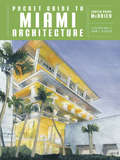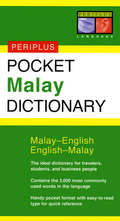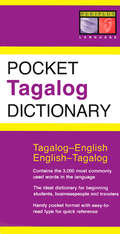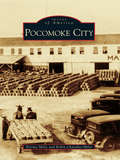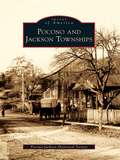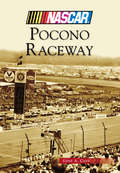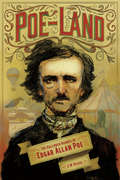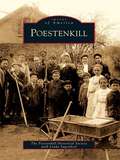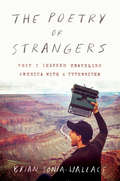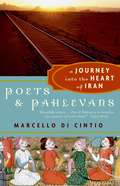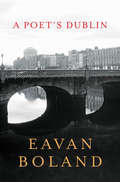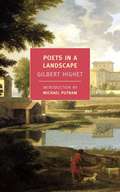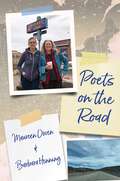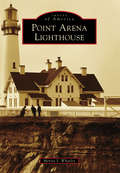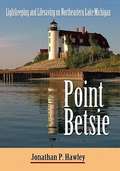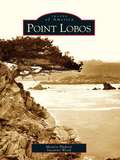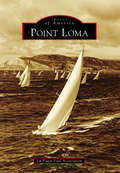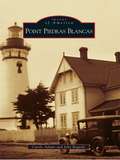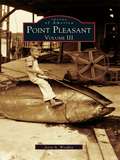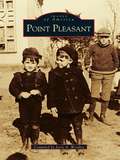- Table View
- List View
Pocket Guide to Miami Architecture (Norton Pocket Guides)
by John F. Desalvo Judith Paine McbrienThis guidebook organizes 100 architectural highlights into walkable tours in downtown Miami and Miami Beach. From the tropical vernacular of the Barnacle House to the Art Deco neighborhoods of Miami Beach, from the Midcentury Modernism of Morris Lapidus to the sophisticated rhythms of Arquitectonica, Judith Paine McBrien captures the vibrancy and diversity of architecture in Miami and its environs. Set in a stunning seaside site, the buildings of Miami, Miami Beach, Coral Gables, and Coconut Grove tell a fascinating story of artifice, innovation, charm, and international influence. This masterfully illustrated guide highlights the buildings that visitors will want to see, among them the City Beautiful planning of Coral Gables; the classical glory of Vizcaya; and the New World Symphony, Frank Gehry's twenty-first-century reinterpretation of the music hall.
Pocket Malay Dictionary
by Zuraidah OmarThis is a pocket sized Malay DictionaryIntended for use by tourists, students, and business people traveling to Malaysia Pocket Malay Dictionary is an essential tool for communicating in Malay. It features all the essential Malay vocabulary appropriate for beginning to intermediate students. It's handy pocket format and easy-to read type will make any future trip to Malaysia much easier. In addition to being an excellent English to Malay dictionary and Malay to English dictionary Pocket Malay Dictionary contains important notes on the Malay language, Malay grammar and Malay pronunciation. All Malay words are written in English and Malay script (Rumi) so that in the case of difficulties the book can simply be shown to the person the user is trying to communicate with.This dictionary contains:The 3,000 most commonly used words in the Malay languageEnglish and Romanized Malay (Rumi)An introduction to and history of the Malay languageInformation on Malay grammarA guide to pronouncing Malay correctlyOther books from this bestselling series you might enjoy are: Pocket Vietnamese Dictionary, Pocket Cambodian Dictionary, Pocket Thai Dictionary, Pocket Indonesian Dictionary, Pocket Mandarin Chinese Dictionary, and Pocket Cantonese Dictionary.
Pocket Malay Dictionary
by Zuraidah OmarThis is a pocket sized Malay DictionaryIntended for use by tourists, students, and business people traveling to Malaysia Pocket Malay Dictionary is an essential tool for communicating in Malay. It features all the essential Malay vocabulary appropriate for beginning to intermediate students. It's handy pocket format and easy-to read type will make any future trip to Malaysia much easier. In addition to being an excellent English to Malay dictionary and Malay to English dictionary Pocket Malay Dictionary contains important notes on the Malay language, Malay grammar and Malay pronunciation. All Malay words are written in English and Malay script (Rumi) so that in the case of difficulties the book can simply be shown to the person the user is trying to communicate with.This dictionary contains:The 3,000 most commonly used words in the Malay languageEnglish and Romanized Malay (Rumi)An introduction to and history of the Malay languageInformation on Malay grammarA guide to pronouncing Malay correctlyOther books from this bestselling series you might enjoy are: Pocket Vietnamese Dictionary, Pocket Cambodian Dictionary, Pocket Thai Dictionary, Pocket Indonesian Dictionary, Pocket Mandarin Chinese Dictionary, and Pocket Cantonese Dictionary.
Pocket Malay Dictionary
by Zuraidah OmarThis is a pocket sized Malay DictionaryIntended for use by tourists, students, and business people traveling to Malaysia Pocket Malay Dictionary is an essential tool for communicating in Malay. It features all the essential Malay vocabulary appropriate for beginning to intermediate students. It's handy pocket format and easy-to read type will make any future trip to Malaysia much easier. In addition to being an excellent English to Malay dictionary and Malay to English dictionary Pocket Malay Dictionary contains important notes on the Malay language, Malay grammar and Malay pronunciation. All Malay words are written in English and Malay script (Rumi) so that in the case of difficulties the book can simply be shown to the person the user is trying to communicate with.This dictionary contains:The 3,000 most commonly used words in the Malay languageEnglish and Romanized Malay (Rumi)An introduction to and history of the Malay languageInformation on Malay grammarA guide to pronouncing Malay correctlyOther books from this bestselling series you might enjoy are: Pocket Vietnamese Dictionary, Pocket Cambodian Dictionary, Pocket Thai Dictionary, Pocket Indonesian Dictionary, Pocket Mandarin Chinese Dictionary, and Pocket Cantonese Dictionary.
Pocket Tagalog Dictionary
by Renato PerdonThis is a pocket sized Tagalog (Filipino) DictionaryIntended for use by tourists, students, and business people traveling to The Philippines Pocket Tagalog Dictionary is an essential tool for communicating in Tagalog. It features all the essential Tagalog vocabulary appropriate for beginning to intermediate students. It's handy pocket format and easy-to read type will make any future trip to The Philippines much easier. In addition to being an excellent English to Tagalog dictionary and Tagalog to English dictionary Pocket Tagalog Dictionary contains important notes on the Tagalog language, Tagalog grammar and Tagalog pronunciation. All Filipino words are written in English and Tagalog so that in the case of difficulties the book can simply be shown to the person the user is trying to communicate with.This dictionary contains:The 3,000 most commonly used words in the Tagalog languageAn introduction to and history of the Tagalog languageInformation on Tagalog grammarA guide to pronouncing Tagalog correctlyOther books from this bestselling series you might enjoy are: Pocket Vietnamese Dictionary, Pocket Cambodian Dictionary, Pocket Thai Dictionary, Pocket Indonesian Dictionary, and Pocket Malay Dictionary.
Pocket Tagalog Dictionary
by Renato PerdonThis is a pocket sized Tagalog (Filipino) DictionaryIntended for use by tourists, students, and business people traveling to The Philippines Pocket Tagalog Dictionary is an essential tool for communicating in Tagalog. It features all the essential Tagalog vocabulary appropriate for beginning to intermediate students. It's handy pocket format and easy-to read type will make any future trip to The Philippines much easier. In addition to being an excellent English to Tagalog dictionary and Tagalog to English dictionary Pocket Tagalog Dictionary contains important notes on the Tagalog language, Tagalog grammar and Tagalog pronunciation. All Filipino words are written in English and Tagalog so that in the case of difficulties the book can simply be shown to the person the user is trying to communicate with.This dictionary contains:The 3,000 most commonly used words in the Tagalog languageAn introduction to and history of the Tagalog languageInformation on Tagalog grammarA guide to pronouncing Tagalog correctlyOther books from this bestselling series you might enjoy are: Pocket Vietnamese Dictionary, Pocket Cambodian Dictionary, Pocket Thai Dictionary, Pocket Indonesian Dictionary, and Pocket Malay Dictionary.
Pocomoke City
by Norma Miles Robin Chandler-MilesIn 1670, Lord Baltimore sent his representative, Col. William Stevens, to claim and develop land in rural Maryland. He established a ferry crossing along the banks of the deep, dark Pocomoke River, and the settlement that would eventually become Pocomoke City was born. Trade flourished; boats filled with lumber, tobacco, and furs sailed on the river to Northern ports, and shipbuilding became a successful enterprise. People flocked to Pocomoke City to work at the lumber mills and in the shipyards, and the little town grew into a small center of commerce with the coming of the Pennsylvania Railroad. In 1922, a devastating fire destroyed 75 percent of the business section of the town, but the community came together and rebuilt what has been called "the Friendliest Town on the Eastern Shore."
Pocono and Jackson Townships
by Pocono-Jackson Historical SocietyPocono Township got its name from the Native Americans, meaning "water between the mountains." Many small towns and villages dotted the landscape along the Native American trails, notably Tannersville in Pocono Township, which was named for its leather tanneries. Jackson Township was named after Andrew Jackson, the seventh United States president, and was primarily a farming and logging community. Jackson Township also became a major supplier of ice, which was harvested on the man-made lakes. The ice was transported on the Wilkes-Barre and Eastern Railroad from the depot in Reeders to Philadelphia, New York, and Jersey City. Over the years, the townships' family and honeymoon resorts, pristine streams for trout fishing, and clear mountain air have helped the area become known as "Pennsylvania's Playground."
Pocono Raceway
by Gene A. CardThe framework for the creation of Pocono Raceway began in the late 1950s, when a group of investors formed Racing Incorporated. In 1962, a spinach farm near Long Pond, Pennsylvania, was chosen as the site for the multifaceted racing complex. Construction on the track began in 1965, but progress moved very slowly. The three-quarter-mile oval portion of the facility was completed in 1968, but it was not until 1971 that the two-and-a-half-mile superspeedway was ready for competition. From its humble beginnings, Pocono Raceway has grown to attract great numbers of enthusiastic spectators to both of its NASCAR® events each year.
Poe-Land: The Hallowed Haunts of Edgar Allan Poe
by J. W. OckerWinner of the 2015 Edgar Award for Best Critical/Biographical! Follow the footsteps of the father of American horror fiction. Edgar Allan Poe was an oddity: his life, literature, and legacy are all, well, odd. In Poe-Land, J. W. Ocker explores the physical aspects of Poe's legacy across the East Coast and beyond, touring Poe's homes, examining artifacts from his life--locks of his hair, pieces of his coffin, original manuscripts, his boyhood bed--and visiting the many memorials dedicated to him. Along the way, Ocker meets people from a range of backgrounds and professions--actors, museum managers, collectors, historians--who have dedicated some part of their lives to Poe and his legacy. Poe-Land is a unique travelogue of the afterlife of the poet who invented detective fiction, advanced the emerging genre of science fiction, and elevated the horror genre with a mastery over the macabre that is arguably still unrivaled today.
Poestenkill
by The Poestenkill Historical Society with Linda SagePoestenkill, formed from the northern half of the township of Sand Lake, was incorporated in 1848 and is the youngest town in Rensselaer County. The name Poestenkill comes from the Dutch and means "foaming creek." The Poestenkill Creek, which runs westerly and empties into the Hudson River, was the center of water-powered industry in the town's early years. When early settlers began arriving and developing the land, Poestenkill was divided into the four hamlets: Poestenkill, East Poestenkill, Ives Corners, and Barberville. Through vintage photographs, Poestenkill provides a glimpse of the town's rich history and draws generations eager to experience the beauty of Poestenkill and the charm of its people.
The Poetry of Strangers: What I Learned Traveling America with a Typewriter
by Brian Sonia-WallaceIt might surprise you who’s a fan of poetry — when it meets them where they are.Before he became an award-winning writer and poet, Brian Sonia-Wallace set up a typewriter on the street with a sign that said “Poetry Store” and discovered something surprising: all over America, people want poems. An amateur busker at first, Brian asked countless strangers, “What do you need a poem about?” To his surprise, passersby opened up to share their deepest yearnings, loves, and heartbreaks. Hundreds of them. Then thousands. Around the nation, Brian’s poetry crusade drew countless converts from all walks of life.In The Poetry of Strangers, Brian tells the story of his cross-country journey in a series of heartfelt and insightful essays. From Minnesota to Tennessee, California to North Dakota, Brian discovered that people aren’t so afraid of poetry when it’s telling their stories. In “dying” towns flourish vibrant artistic spirits and fascinating American characters who often pass under the radar, from the Mall of America’s mall walkers to retirees on Amtrak to self-proclaimed witches in Salem. In a time of unprecedented loneliness and isolation, Brian’s journey shows how art can be a vital bridge to community in surprising places. Conventional wisdom says Americans don’t want to talk to each other, but according to this poet-for-hire, everyone is just dying to be heard.Thought-provoking, moving, and eye-opening, The Poetry of Strangers is an unforgettable portrait of America told through the hidden longings of one person at a time, by one of our most important voices today. The fault lines and conflicts which divide us fall away when we remember to look, in every stranger, for poetry.
Poets and Pahlevans: A Journey into the Heart of Iran
by Marcello Di CintioMarcello Di Cintio prepares for his "journey into the heart of Iran" with the utmost diligence. He takes lessons in Farsi, researches Persian poetry and sharpens his wrestling skills by returning to the mat after a gap of some years. Knowing that there is a special relationship between heroic poetry and the various styles of traditional Persian wrestling, he sets out to discover how Iranians "reconcile creativity with combat."From the moment of his arrival in Tehran, the author is overwhelmed by hospitality. He immerses himself in male company in tea houses, conversing while smoking the qalyun or water pipe. Iranian men are only too willing to talk, especially about politics. Confusingly, he is told conflicting statements-that all Iranians love George Bush, that all Iranians hate George Bush; that life was infinitely better under the Shah, that the mullahs swept away the corruption of the Shah's regime and made life better for all.Once out of Tehran, he learns where the traditional forms of wrestling are practised. His path through the country is directed by a search for the variant disciplines and local techniques of wrestling and a need to visit sites and shrines associated with the great Persian poets: Hafez, Ferdosi, Omar Khayyám, Attar, Shahriyar and many others. Everywhere his quest leads him, he discovers that poetry is loved and quoted by everyone from taxi-drivers to students.His engagement with Iranian culture is intimate: he wrestles (sometimes reluctantly) when invited, samples illegal home-brew alcohol, attends a wedding, joins mourners, learns a new way to drink tea and attempts to observe the Ramazan fast, though not a Muslim himself. Though he has inevitable brushes with officialdom, he never feels in danger, even when he hears that a Canadian photo-journalist has apparently been beaten to death in a police cell during the author's visit. The outraged and horrified reaction of those around him to this violent act tightens the already close bond he has formed with the Persians.His greatest frustration is that he is unable to converse freely with Iranian women aware that an important part of his picture of Iran is thus absent. Yet the mosaic of incidents, encounters, vistas, conversations, atmospheres and acutely observed sights, smells and moments creates a detailed impression of a country and society that will challenge most, if not all, preconceptions.From the Hardcover edition.
A Poet's Dublin
by Eavan BolandJuxtaposing verse and image, A Poet's Dublin is a study of origin and influence from "a major Irish poet" (Edward Hirsch). Written over years, the transcendent and moving poems in A Poet's Dublin seek out shadows and impressions of a powerful, historic city, studying how it forms and alters language, memory, and selfhood. The poems range from an evocation of the neighborhoods under the hills where the poet lived and raised her children to the inner-city bombing of 1974, and include such signature poems as "The Pomegranate," "The War Horse," and "Anna Liffey." Above all, these poems weave together the story of a self and a city--private, political, and bound by history. The poems are supported by photographs of the city at all times and in all seasons: from dawn on the river Liffey, which flows through Dublin, to twilight up in the Dublin foothills.
Poets In A Landscape
by Gilbert HighetGilbert Highet was a legendary teacher at Columbia University, admired both for his scholarship and his charisma as a lecturer. Poets in a Landscape is his delightful exploration of Latin literature and the Italian landscape. As Highet writes in his introduction, “I have endeavored to recall some of the greatest Roman poets by describing the places were they lived, recreating their characters and evoking the essence of their work. ” The poets are Catullus, Vergil, Propertius, Horace, Tibullus, Ovid, and Juvenal. Highet brings them life, setting them in their historical context and locating them in the physical world, while also offering crisp modern translations of the poets’ finest work. The result is an entirely sui generis amalgam of travel writing, biography, criticism, and pure poetry—altogether an unexcelled introduction to the world of the classics.
Poets on the Road
by Maureen Owen Barbara HenningCalling to mind Basho¯&’s late life journeys through the backcountry of Japan, two women poets in a well-worn Honda hit the road for a legendary pilgrimage in a far-flung (pre-pandemic) landscape of American poetry.Although a road trip across North American calls to mind Jack Kerouac&’s youthful meanderings of self-discovery, this reading tour was more in the manner of Basho¯&’s late life journeys through the backcountry of Japan. . . . The road trip was in a sense a pilgrimage of reengagement with their calling as poets, and a chance to reacquaint with like-minded friends, old and new, in a far-flung landscape of American poetry. Venues would include upscale bookstores, coffee houses, museums, legendary used bookstores, botanical gardens, university classrooms, art centers, and artist coops—in short, a unique sampling of poetry environments tracing an arc across the Southern States, the Southwest, and up the West Coast before hooking back to the Rockies. Framed as a personal challenge, the poets hit the road much in the manner of itinerant preachers and musicians, lodging at discount motels, funky hostels, Airbnbs, and with friends along the way. Adding a social media touch, Maureen and Barbara created a blog of their tour so that friends, family, hosts, and fellow poets might also share in their adventure. —from the Introduction by Pat Nolan
Pohnpei, An Island Argosy
by Gene AshbyAll you ever wanted to know about Pohnpei's history, culture, and languages.
Point Arena Lighthouse
by Merita S. WhatleyThe low rumbles of the fog signal and flashing beam of light from the powerful lens have guided mariners away from the perilous waters surrounding Point Arena Lighthouse since 1870. After the great earthquake in 1906 and the rebuilding of the tower in 1908, Point Arena's navigational aids continued to warn ships away from the peninsula off Northern California's Pacific coastline. The original tower was replaced with a concrete cylindrical tower that rises 115 feet from the headland. This became the first lighthouse tower in the United States constructed with materials found to be superior to the stone and masonry lighthouse structures of the past. The new tower, crowned with a nearly 13,000-pound first-order Fresnel lens, sent a beam of light 20 miles out to sea and continued alerting ships of the dangers just offshore.
Point Betsie: Lightkeeping and Lifesaving on Northeastern Lake Michigan
by Jonathan P. HawleyPoint Betsie: Lightkeeping and Lifesaving on Northeastern Lake Michigan is the compelling story of a key Great Lakes lighthouse whose beam has pierced night skies for 150 years. This rich history recounts the efforts of the U. S. Lighthouse Service, the U. S. Life-Saving Service, and the U. S. Coast Guard on Lake Michigan's wreck-strewn northeastern coast, near the treacherous Manitou Passage. Much of Point Betsie's story is told in the accounts of dedicated keepers who served there with their families since 1858. Photographs also chronicle the lighthouse's expanding services through the years and the site's transition from early isolation to today's frequently visited attraction on Lake Michigan's northeastern shore. The author devotes equal attention to the courageous lifesaving crews that served mariners off Point Betsie from 1877 to 1937. Keepers' logs bring to life the heroic rescues from wrecks that surfmen discovered while conducting their lonely night-time beach patrols, and document Point Betsie's central but previously untold role in the area's important maritime and social history. Point Betsie also covers the "laker" fleet's evolution from wooden sailing vessels to massive steamships. Lighthouse operations are detailed, starting with Point Betsie's original oil lamps and then state-of-the-art Fresnel lens, and culminating with the electrically powered, automated beacon that now shines atop this historic and revered tower.
Point Lobos
by Monica Hudson Suzanne WoodFor more than a century the incomparable beauty of Point Lobos has drawn admirers from around the world. The jagged rock outcroppings, driftwood-strewn beaches, and silhouetted cypress trees, twisted grotesquely by the wind, were favorite subjects for photographers Ansel Adams and Edward Weston. Point Lobos is also a favorite playground for seals, sea lions, and otters, and migrating grey whales pass just offshore. Barking sea lions reminded 18th-century Spanish explorers of sea wolves, in their tongue, lobos marinos, and so they named it Point of the Sea Wolves. Now a California State Reserve, Point Lobos draws hundreds of thousands of visitors a year.
Point Loma (Images of America)
by La Playa Trail AssociationFrom the arrival of Juan Rodriguez Cabrillo in 1542 to the current world-class yachtsmen and women, San Diego's beautiful natural harbor hugs the peninsula of Point Loma and boasts a significant past. The strategic location of Point Loma has been home to both military defense and business genius. The fishing fleets of the Chinese and Portuguese communities earned the Roseville area of Point Loma the nickname "Tunaville." Today, Point Loma is one of San Diego's most historic neighborhoods; a destination for culture, fine dining, and sportfishing; and host to important military bases. Visitors from around the world enjoy spectacular vistas and waterfront views of the Pacific Ocean, harbor, city, and islands and mountains of Mexico from atop the peninsula at Cabrillo National Monument and Fort Rosecrans National Cemetery.
Point Piedras Blancas (Images of America)
by Carole Adams John H. BogackiFor thousands of years, Point Piedras Blancas, located along the central coast of California, has attracted people to its rocky, windswept shores. In ancient times, it was used by Native American cultures. Since 1875, it has been the site of a First Order Lighthouse, warning ships to steer clear of its rocky shoals, a duty it continues to fulfill. Although the years have not been kind to this stunning area nor to the lighthouse, new life is being breathed into it by a partnership of enthusiastic community volunteers and government agencies. Their common goal is to restore this magnificent site to its original state while reintroducing the natural environment that was almost obliterated during the past four decades.
Point Pleasant: Volume III (Images of America)
by Jerry A. WooleyPoint Pleasant Volume I and Volume II have captivated audiences, and now, in this new addition to the Images of America series, author Jerry Woolley offers us a third volume of images to help us connect with our past. In Point Pleasant Volume III, we are invited to take a stroll down memory lane and see the area's residents at work and at play, boating and fishing, and simply relaxing on the beach. Also featured within these pages are a variety of snapshots of the places and events that have given this community its Old World familiarity. Its no wonder that Point Pleasant and Point Pleasant Beach have been popular tourist destinations for more than two centuries.
Point Pleasant (Images of America)
by Jerry A. WoolleySince the development of photography in the midnineteenth century, the camera has been used as a tool of both discovery and preservation. Photographs bring alive our image of the past, and can open a floodgate of memories and nostalgia or inspire curiosity and a sense of history. Point Pleasant and Point Pleasant Beach have always been two of New Jersey's most dynamic coastal communities. The scenic beauty and simple charm of the area remains undisturbed today, and it is easy to see why it has been a popular tourist destination for more than two centuries. The last one hundred years have also seen the formation and development of several important industries in the region, including shipbuilding and commercial fishing. This combination of business and recreation, of modern industry and Old World charm, is why Point Pleasant and Point Pleasant Beach remain two of the most vivacious and magnetic communities on the coast of New Jersey.
Point Reyes Complete Guide
by Jessica LageOnly 30 miles from San Francisco, Point Reyes National Seashore attracts admirers year-round to its forests, wetlands, and beaches. Visitors come to this tranquil place to hike, camp, backpack, bike, kayak, horseback ride, picnic, fish, and nature-watch. This invaluable resource gives detailed information on the trails, roads, camps, and and beaches within the Seashore, plus surrounding parks and preserves. Point Reyes: The Complete Guide to the National Seashore & Surrounding Area has much more than coverage of all the popular recreational activities and hiking trails.
